change time Alfa Romeo 147 2008 Owner handbook (in English)
[x] Cancel search | Manufacturer: ALFA ROMEO, Model Year: 2008, Model line: 147, Model: Alfa Romeo 147 2008Pages: 291, PDF Size: 5.52 MB
Page 134 of 291

GETTING TO KNOW YOUR CAR
132fig. 135
A0A0199m
For correct adjustment, bear in mind the
following conditions:
– position 0: one or two people occupy-
ing the front seats
– position 1: five people;
– position 2: five people + load in the
boot;
– position 3: driver + maximum permis-
sible load all stowed in lug-
gage compartmentCOMPENSATION FOR TILT
(fig. 134)(excluding versions
with Xenon headlights)
When the vehicle is loaded, the beam from
the headlights is raised due to the back-
wards tilt of the vehicle.
In this case the headlights must be ad-
justed correctly.
To do this, use the rocker button (A), on
the plate at the side of the steering column:
– press the arrow on the button (
A), this
will increase by one position (eg.: 0
➟1
➟ 2➟3);
– press the arrow on the button (
S), this
will lower by one position (eg.: 3
➟2➟
1➟0);
The display (B), in the tachometer shows
the positions while adjustment is being
made.
fig. 134
A0A0467m
HEADLIGHTS
The adjustment of the headlights is vital to
your safety and comfort and to that of oth-
er road users.
The adjustment of the headlights is also
governed by precise regulations.
Contact Alfa Romeo Authorised Services to
have the headlights correctly adjusted.
IMPORTANTOn the inside surface of
the headlight there could appear a slight
coat of fogging; this does not show a defect,
since it is a natural occurrence due to low
temperature and to the degree of humidity
in the air; it will soon disappear as soon as
the lights are turned on. The presence of
drops inside the headlight shows water seep-
age, refer to the Alfa Romeo Dealership.
Check beam aiming every
time the load carried
changes.
WARNING
Page 140 of 291
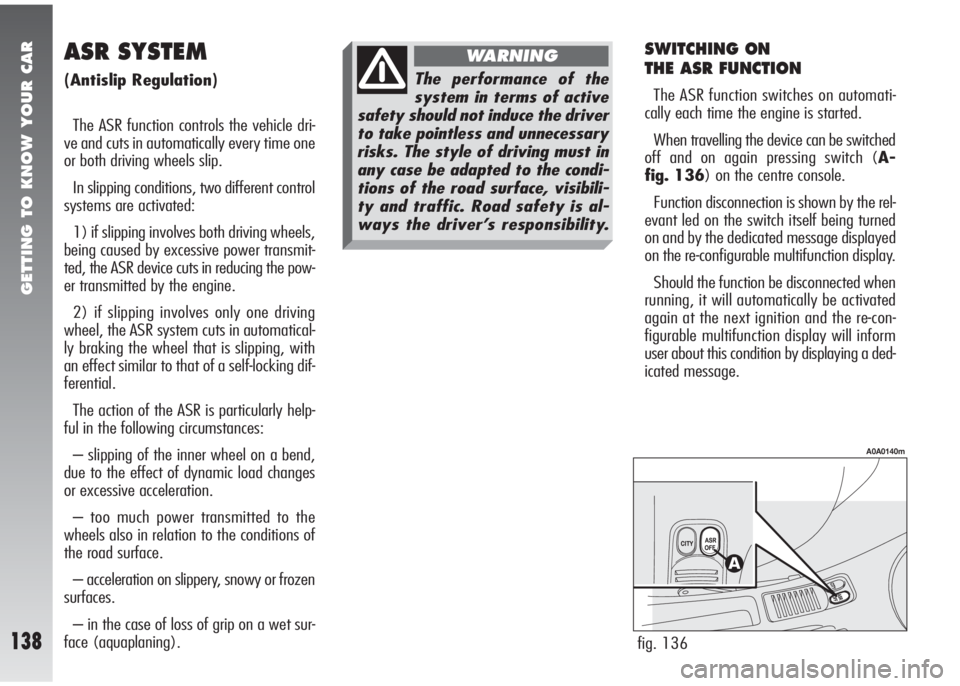
GETTING TO KNOW YOUR CAR
138
SWITCHING ON
THE ASR FUNCTION
The ASR function switches on automati-
cally each time the engine is started.
When travelling the device can be switched
off and on again pressing switch (A-
fig. 136) on the centre console.
Function disconnection is shown by the rel-
evant led on the switch itself being turned
on and by the dedicated message displayed
on the re-configurable multifunction display.
Should the function be disconnected when
running, it will automatically be activated
again at the next ignition and the re-con-
figurable multifunction display will inform
user about this condition by displaying a ded-
icated message.
fig. 136
A0A0140m
ASR SYSTEM
(Antislip Regulation)
The ASR function controls the vehicle dri-
ve and cuts in automatically every time one
or both driving wheels slip.
In slipping conditions, two different control
systems are activated:
1) if slipping involves both driving wheels,
being caused by excessive power transmit-
ted, the ASR device cuts in reducing the pow-
er transmitted by the engine.
2) if slipping involves only one driving
wheel, the ASR system cuts in automatical-
ly braking the wheel that is slipping, with
an effect similar to that of a self-locking dif-
ferential.
The action of the ASR is particularly help-
ful in the following circumstances:
– slipping of the inner wheel on a bend,
due to the effect of dynamic load changes
or excessive acceleration.
– too much power transmitted to the
wheels also in relation to the conditions of
the road surface.
– acceleration on slippery, snowy or frozen
surfaces.
– in the case of loss of grip on a wet sur-
face (aquaplaning).The performance of the
system in terms of active
safety should not induce the driver
to take pointless and unnecessary
risks. The style of driving must in
any case be adapted to the condi-
tions of the road surface, visibili-
ty and traffic. Road safety is al-
ways the driver’s responsibility.
WARNING
Page 146 of 291

GETTING TO KNOW YOUR CAR
144
Sound section
– Pause Function
– Loudness Function (except versions with
BOSE HI-FI system)
– 7 band graphic equalizer
– Separate bass/treble adjustment
– Right/left and front/rear channel bal-
ancing.
CAUTIONS
If it is very cold inside the car and the CD
player is used a little after turning the heater
on, a film of damp may form on the Com-
pact Disc or on the player optics and the
sound may not be perfect. In this case do
not use the CD player for at least an hour,
so that the condensation dissolves natural-
ly and normal operation is resumed.
Driving on rough roads with heavy vibra-
tions may cause skipping when the CD play-
er is working.
PROTECTION AGAINST THEFT
The radio is fitted with an antitheft pro-
tection system based on the exchange of in-
formation between the radio and the elec-
tronic control unit (Body Computer) installed
on the car. This system warrants the high-
est level of security and prevents entry of
the secret code every time the radio sup-
ply is disconnected.
After every re-connection an automatic
check procedure is performed during which
the display shows the wording “CAN-
CHECK” for about one second. If the result
of the check is positive, the set starts work-
ing, whereas if the comparison codes are
not the same or if the radio is connected for
the first time to the vehicle electric system,
the device informs the user of the need to
enter the secret code according to the pro-
cedure described in the following paragraph.
During the code entry procedure the dis-
play shows the word “CODE”. The set will
not work until the correct code is entered
This way the protection system makes the
radio unusable after removal from the dash-
board in the case of theft.On multimedia CDs in addi-
tion to sound tracks also
data tracks are recorded. Playing
one of these CDs may cause rustling
and such a volume as to compro-
mise road safety, as well as caus-
ing damage to the final stages and
speakers.
WARNING
Page 147 of 291
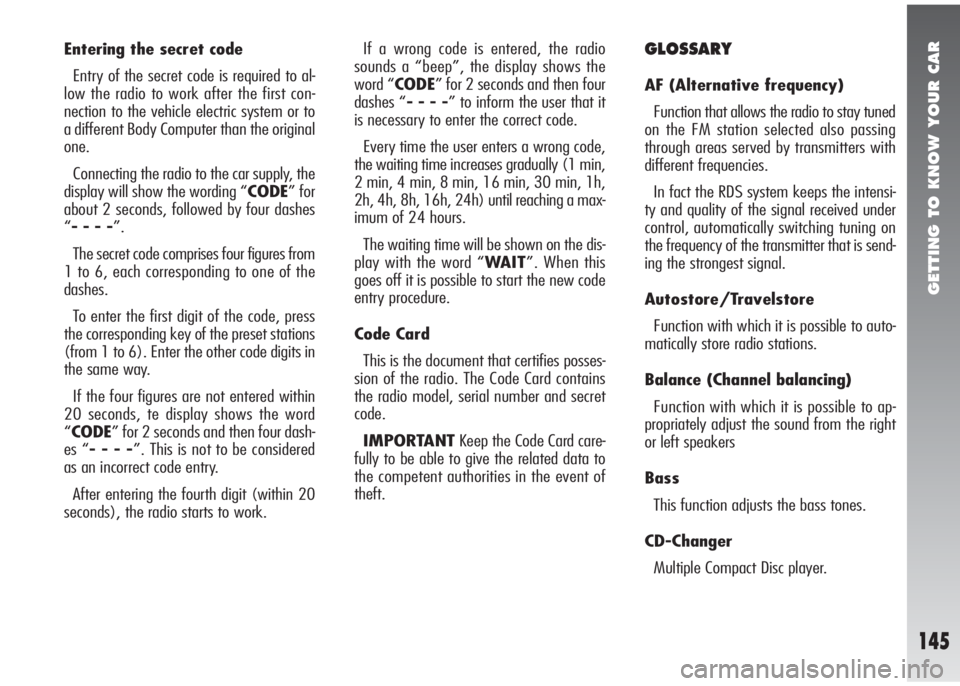
GETTING TO KNOW YOUR CAR
145
Entering the secret code
Entry of the secret code is required to al-
low the radio to work after the first con-
nection to the vehicle electric system or to
a different Body Computer than the original
one.
Connecting the radio to the car supply, the
display will show the wording “CODE” for
about 2 seconds, followed by four dashes
“- - - -”.
The secret code comprises four figures from
1 to 6, each corresponding to one of the
dashes.
To enter the first digit of the code, press
the corresponding key of the preset stations
(from 1 to 6). Enter the other code digits in
the same way.
If the four figures are not entered within
20 seconds, te display shows the word
“CODE” for 2 seconds and then four dash-
es “- - - -”. This is not to be considered
as an incorrect code entry.
After entering the fourth digit (within 20
seconds), the radio starts to work.If a wrong code is entered, the radio
sounds a “beep”, the display shows the
word “CODE” for 2 seconds and then four
dashes “- - - -” to inform the user that it
is necessary to enter the correct code.
Every time the user enters a wrong code,
the waiting time increases gradually (1 min,
2 min, 4 min, 8 min, 16 min, 30 min, 1h,
2h, 4h, 8h, 16h, 24h) until reaching a max-
imum of 24 hours.
The waiting time will be shown on the dis-
play with the word “WAIT”. When this
goes off it is possible to start the new code
entry procedure.
Code Card
This is the document that certifies posses-
sion of the radio. The Code Card contains
the radio model, serial number and secret
code.
IMPORTANTKeep the Code Card care-
fully to be able to give the related data to
the competent authorities in the event of
theft.GLOSSARY
AF (Alternative frequency)
Function that allows the radio to stay tuned
on the FM station selected also passing
through areas served by transmitters with
different frequencies.
In fact the RDS system keeps the intensi-
ty and quality of the signal received under
control, automatically switching tuning on
the frequency of the transmitter that is send-
ing the strongest signal.
Autostore/Travelstore
Function with which it is possible to auto-
matically store radio stations.
Balance (Channel balancing)
Function with which it is possible to ap-
propriately adjust the sound from the right
or left speakers
Bass
This function adjusts the bass tones.
CD-Changer
Multiple Compact Disc player.
Page 152 of 291

GETTING TO KNOW YOUR CAR
150
6.Multifunction button:
– Radio: call preset stations (from 6 to
1)
– Compact Disc player: select previous
track.
Volume adjustment and Mute
buttons
The buttons for volume adjustment (1) e
(2) and for turning Mute on/off (3) work
in the same way as the corresponding but-
tons on the radio.
Radio frequency and sound
source select button
To cyclically select the radio frequencies
and sound sources, briefly and repeatedly
press button (4).
The frequencies/sources available are:
FMI, FMII, FMT, MW, LW, CD*, CDC**.
(*) Only if the Compact Disc is inserted
(**) Only if the CD-Changer is connected
Multifunction buttons (5) and (6)
Multifunction buttons (5) and (6) call the
preset radio stations, or select the next/pre-
vious track when listening to a Compact
Disc.
Press button (5) to select stations from
1 to 6 or to listen to the next track on a CD.
Press button (6) to select stations from
6 to 1 or to listen to the previous track on
a CD.
FUNCTIONS AND
ADJUSTMENTS
(fig. 137)
Switching on
The set is turned on keeping the “ON”
button pressed (20). If the radio was on
before the engine was turned off, it will turn
on again automatically the next time the en-
gine is started.
If the radio is turned on with the ignition
key at STOP, it will turn off automatically
after about 20 minutes.
With the ignition key at MARthe “ON”
button is always lit to facilitate turning on
the radio.When the radio is turned on again it will
resume with the same settings that were
working before turning off, with the excep-
tion of the volume which, if it was set to
above 20, it is activated at 20.
Turning the radio off
To turn off keep the “ON”button (20)
pressed again
If the ignition key is turned to STOPwhen
the radio is on, it will turn off automatical-
ly and turn on again the next time the key
is turned to MAR.
Selecting the Radio/Compact
Disc/CD-Changer functions
Briefly and repeatedly pressing the “SRC”
button (14) it is possible to select the fol-
lowing functions in sequence:
– TUNER (Radio)
– CD (only if the Compact Disc is inserted)
– CHANGER (only if the CD-Changer is con-
nected).
After each change of the sound source, for
about 2.5 seconds, the display shows the
function selected: TUNER(Radio),CD
(Compact Disc), CHANGER(CD-Changer).
Page 155 of 291
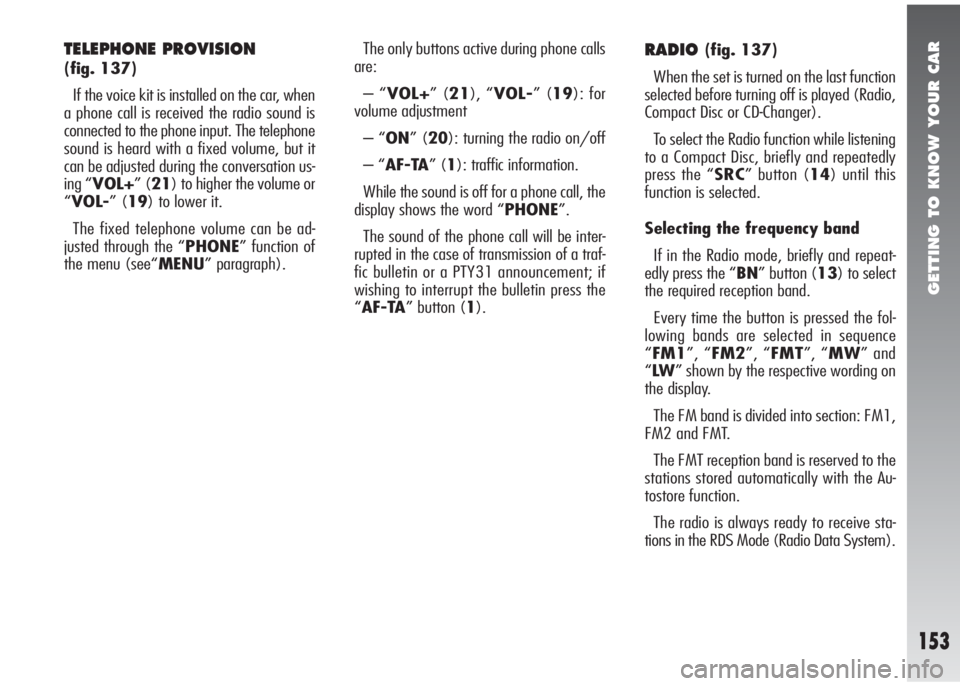
GETTING TO KNOW YOUR CAR
153
TELEPHONE PROVISION
(fig. 137)
If the voice kit is installed on the car, when
a phone call is received the radio sound is
connected to the phone input. The telephone
sound is heard with a fixed volume, but it
can be adjusted during the conversation us-
ing “VOL+” (21) to higher the volume or
“VOL-” (19) to lower it.
The fixed telephone volume can be ad-
justed through the “PHONE” function of
the menu (see“MENU” paragraph). The only buttons active during phone calls
are:
– “VOL+” (21), “VOL-” (19): for
volume adjustment
– “ON” (20): turning the radio on/off
– “AF-TA” (1): traffic information.
While the sound is off for a phone call, the
display shows the word “PHONE”.
The sound of the phone call will be inter-
rupted in the case of transmission of a traf-
fic bulletin or a PTY31 announcement; if
wishing to interrupt the bulletin press the
“AF-TA” button (1).
RADIO(fig. 137)
When the set is turned on the last function
selected before turning off is played (Radio,
Compact Disc or CD-Changer).
To select the Radio function while listening
to a Compact Disc, briefly and repeatedly
press the “SRC” button (14) until this
function is selected.
Selecting the frequency band
If in the Radio mode, briefly and repeat-
edly press the “BN” button (13) to select
the required reception band.
Every time the button is pressed the fol-
lowing bands are selected in sequence
“FM1”, “FM2”, “FMT”, “MW” and
“LW” shown by the respective wording on
the display.
The FM band is divided into section: FM1,
FM2 and FMT.
The FMT reception band is reserved to the
stations stored automatically with the Au-
tostore function.
The radio is always ready to receive sta-
tions in the RDS Mode (Radio Data System).
Page 159 of 291

GETTING TO KNOW YOUR CAR
157
The behaviour of the set during Autostore
is as follows:
– at the beginning of the Autostore func-
tion all the other functions are disabled
– any change in volume is not shown on
the display
– pressing one of the radio function but-
tons, for example “PTY” (2), “
˙˙” (7),
“
¯¯” (4), (17), (16), (15), (12),
(11), (10) the automatic storage process
is interrupted, the last station heard before
Autostore was turned on is tuned and the
function associated with the button pressed
is run
– pressing “AF-TA” (1) during auto-
matic storage will interrupt it, the TA func-
tion (traffic information) will be turned
on/off and a new automatic storage process
will be started
– Changing the sound source (Radio, Com-
pact Disc, CD-Changer) during automatic
storage, Autostore is not interrupted.
IMPORTANTSometimes the Autostore
function is unable to find 6 stations with a
strong signal. In this case, the free presetting
buttons will be shown on the display, for
about 2 seconds, by 4 dashes and the last
station heard will be returned.Listening to stored stations
Proceed as follows:
– select the required frequency band (FM,
MW, LW)
– briefly press one of the six station stor-
age buttons.
The display will show the number that cor-
responds to the button.
In bands FM1, FM2 and FMT, if reception
is poor and the AF alternative frequency
search function is active, the station with the
strongest signal that is broadcasting the
same programme will be sought automati-
cally. AF Function
(alternative frequency search)
Within the RDS system the radio can work
in two different modes:
AF ON: alternative frequency search on
AF OFF: alternative frequency search off.
When the signal of the RDS station tuned
weakens, the following two cases may oc-
cur:
– With AF ONthe RDS system activates
automatic tuning of the optimum frequency
of the station chosen, with the stations en-
abled, therefore the radio is automatically
tuned to the station with the strongest sig-
nal that is broadcasting the same pro-
gramme. During the journey it will thus be
possible to continue listening to the station
chosen without having to change the fre-
quency when changing area. Of course, the
station being listened to must be receivable
in the area the car is crossing.
– With AF OFFthe radio will not tune
the strongest station automatically and it
will have to be found manually using the
tuner buttons.
Page 160 of 291
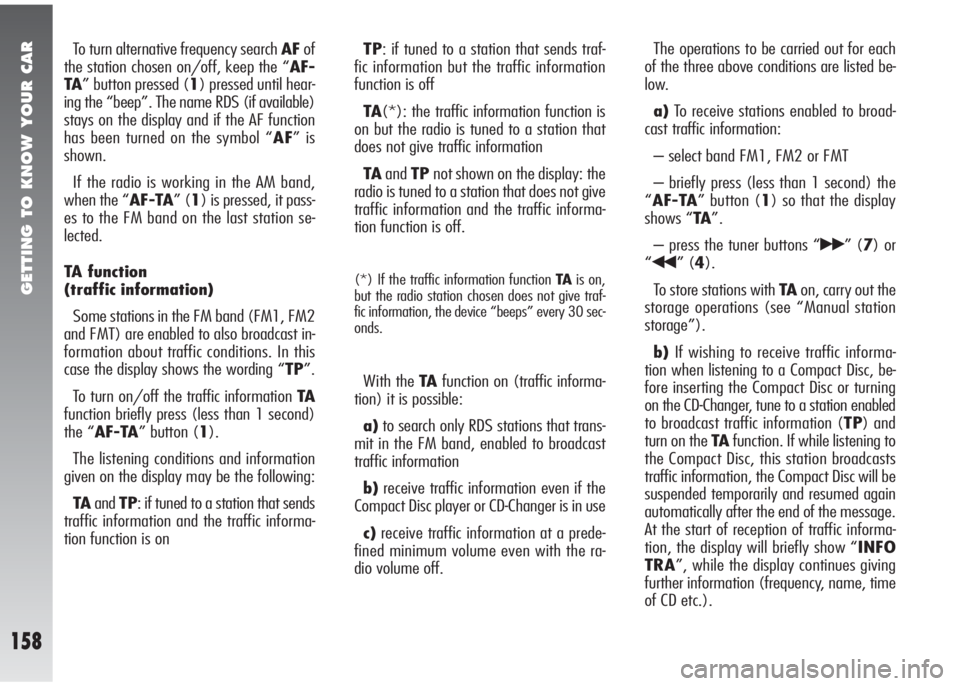
GETTING TO KNOW YOUR CAR
158
To turn alternative frequency search AFof
the station chosen on/off, keep the “AF-
TA” button pressed (1) pressed until hear-
ing the “beep”. The name RDS (if available)
stays on the display and if the AF function
has been turned on the symbol “AF” is
shown.
If the radio is working in the AM band,
when the “AF-TA” (1) is pressed, it pass-
es to the FM band on the last station se-
lected.
TA function
(traffic information)
Some stations in the FM band (FM1, FM2
and FMT) are enabled to also broadcast in-
formation about traffic conditions. In this
case the display shows the wording “TP”.
To turn on/off the traffic information TA
function briefly press (less than 1 second)
the “AF-TA” button (1).
The listening conditions and information
given on the display may be the following:
TAandTP: if tuned to a station that sends
traffic information and the traffic informa-
tion function is onTP: if tuned to a station that sends traf-
fic information but the traffic information
function is off
TA(*): the traffic information function is
on but the radio is tuned to a station that
does not give traffic information
TAandTPnot shown on the display: the
radio is tuned to a station that does not give
traffic information and the traffic informa-
tion function is off.
(*) If the traffic information function TAis on,
but the radio station chosen does not give traf-
fic information, the device “beeps” every 30 sec-
onds.
With the TAfunction on (traffic informa-
tion) it is possible:
a)to search only RDS stations that trans-
mit in the FM band, enabled to broadcast
traffic information
b)receive traffic information even if the
Compact Disc player or CD-Changer is in use
c)receive traffic information at a prede-
fined minimum volume even with the ra-
dio volume off.The operations to be carried out for each
of the three above conditions are listed be-
low.
a)To receive stations enabled to broad-
cast traffic information:
– select band FM1, FM2 or FMT
– briefly press (less than 1 second) the
“AF-TA” button (1) so that the display
shows “TA”.
– press the tuner buttons “
˙˙” (7) or
“
¯¯” (4).
To store stations with TAon, carry out the
storage operations (see “Manual station
storage”).
b)If wishing to receive traffic informa-
tion when listening to a Compact Disc, be-
fore inserting the Compact Disc or turning
on the CD-Changer, tune to a station enabled
to broadcast traffic information (TP) and
turn on the TAfunction. If while listening to
the Compact Disc, this station broadcasts
traffic information, the Compact Disc will be
suspended temporarily and resumed again
automatically after the end of the message.
At the start of reception of traffic informa-
tion, the display will briefly show “INFO
TRA”, while the display continues giving
further information (frequency, name, time
of CD etc.).
Page 161 of 291

GETTING TO KNOW YOUR CAR
159
If the Compact Disc player is already work-
ing and at the same time you want to re-
ceive traffic information, briefly pressing
(less than 1 second) the “AF-TA” button
(1) the radio tunes to the last station heard
in the FM band, the TA traffic information
function is activated and the traffic messages
are transmitted. If the station selected does
not send traffic information, the search for
an enabled station starts automatically.
If wishing to interrupt the traffic informa-
tion message, briefly press (less than 1 sec-
ond) the “AF-TA” button (1) during trans-
mission of the message.
c)To receive traffic information while not
listening to the radio:
– turn on the TAfunction, briefly pressing
(less than 1 second) “AF-TA” button (1),
so that the display shows “TA”
– tune to a station enabled to transmit
traffic information so that the display
shows“TP” take the volume to zero keep-
ing the “VOL-” button pressed (19).
This way, if that station broadcasts traffic
information, this will be heard at a minimum
predefined volume. IMPORTANTIn certain countries radio
stations exist which, even if the TPfunction
is on (the display shows “TP”), do not
transmit traffic information.
If the radio is working in the AM band
when the “AF-TA” button (1) is pressed,
it passes to the FM band on the last sta-
tion heard. If the station selected does not
broadcast traffic information (wording “TP”
not shown on the display), the search for
an enabled station starts automatically.
The volume with which the traffic bulletin
is transmitted varies depending on the lis-
tening volume:
– listening volume below 30: traffic bul-
letin volume = 20 (fixed value)
– listening volume above 30: traffic bul-
letin volume the same as the listening vol-
ume + 1.
If the volume is changed during a traffic
bulletin the value is not shown on the dis-
play and the new value is kept only for the
bulletin in progress.
During a traffic bulletin it is possible to turn
on sound adjustment with the “AUD” but-
ton (18). The new values set are also kept
at the end of the bulletin.IMPORTANTIf the TAfunction is on
and the station tuned is not able to provide
traffic information or it is no longer able to
provide this information (the display will not
show “TP”), so after 1 minute in which the
radio is in these conditions:
– if listening to a Compact Disc another
station is sought that is enabled to trans-
mit traffic information
– if when listening to the radio a “beep”
is given to alert that it is not possible to re-
ceive traffic information; to interrupt it, it is
necessary to tune to a station that can pro-
vide traffic information or switch off the TA
function.
Page 164 of 291
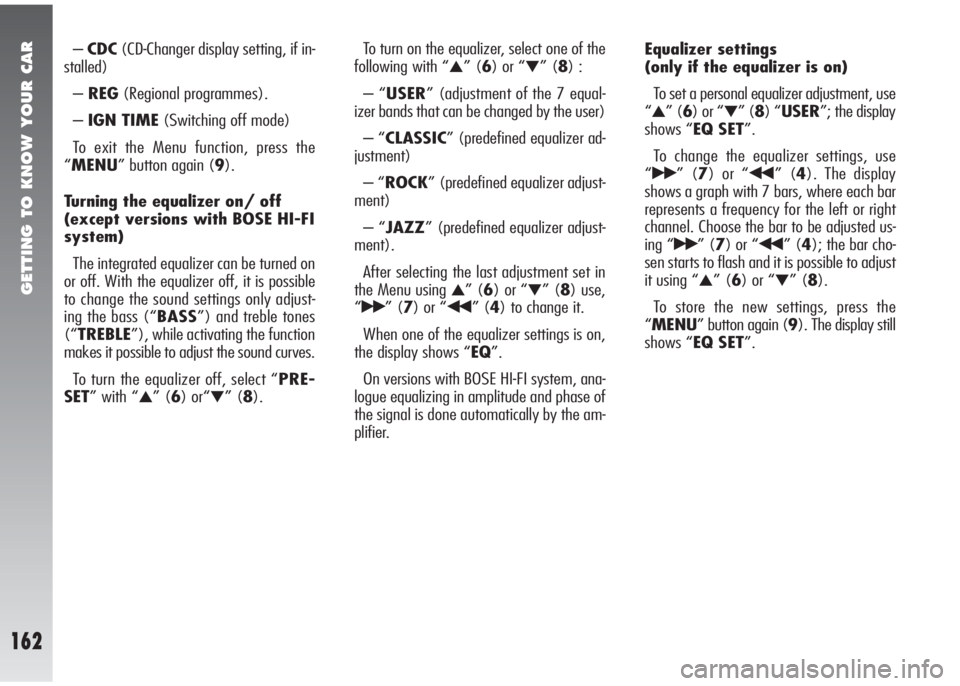
GETTING TO KNOW YOUR CAR
162
–CDC(CD-Changer display setting, if in-
stalled)
–REG(Regional programmes).
–IGN TIME(Switching off mode)
To exit the Menu function, press the
“MENU” button again (9).
Turning the equalizer on/ off
(except versions with BOSE HI-FI
system)
The integrated equalizer can be turned on
or off. With the equalizer off, it is possible
to change the sound settings only adjust-
ing the bass (“BASS”) and treble tones
(“TREBLE”), while activating the function
makes it possible to adjust the sound curves.
To turn the equalizer off, select “PRE-
SET” with “
▲” (6) or“▼” (8).To turn on the equalizer, select one of the
following with “
▲” (6) or “▼” (8) :
– “USER” (adjustment of the 7 equal-
izer bands that can be changed by the user)
– “CLASSIC” (predefined equalizer ad-
justment)
– “ROCK” (predefined equalizer adjust-
ment)
– “JAZZ” (predefined equalizer adjust-
ment).
After selecting the last adjustment set in
the Menu using
▲” (6) or “▼” (8) use,
“
˙˙” (7) or “¯¯” (4) to change it.
When one of the equalizer settings is on,
the display shows “EQ”.
On versions with BOSE HI-FI system, ana-
logue equalizing in amplitude and phase of
the signal is done automatically by the am-
plifier.Equalizer settings
(only if the equalizer is on)
To set a personal equalizer adjustment, use
“
▲” (6) or “▼” (8) “USER”; the display
shows “EQ SET”.
To change the equalizer settings, use
“
˙˙” (7) or “¯¯” (4). The display
shows a graph with 7 bars, where each bar
represents a frequency for the left or right
channel. Choose the bar to be adjusted us-
ing “
˙˙” (7) or “¯¯” (4); the bar cho-
sen starts to flash and it is possible to adjust
it using “
▲” (6) or “▼” (8).
To store the new settings, press the
“MENU” button again (9). The display still
shows “EQ SET”.